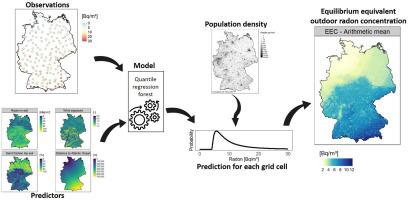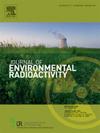Mapping the exposure to outdoor radon in the German population
IF 1.9
3区 环境科学与生态学
Q3 ENVIRONMENTAL SCIENCES
引用次数: 0
Abstract
Introduction
Data on outdoor radon are generally scarce compared to indoor radon. However, knowledge of the spatial distribution of outdoor radon is necessary to estimate the overall exposure of the population to radon, it supports the prediction of indoor radon and characterizes the natural radon background. Germany has a comprehensive dataset on long-term outdoor radon concentration and the equilibrium factor at national level, which allowed to produce what is probably the only spatially continuous outdoor radon map at national level so far.
Data
In this study, outdoor radon concentration measurement data (n = 172) and equilibrium factors (n = 25) from a national survey from 2003 to 2006 were reanalyzed using state-of-the-art machine learning routines. Spatially comprehensive maps of distance to the sea, radon concentration in soil, sand content in topsoil and a terrain-based wind exposure index are used as predictors.
Methods
Quantile regression forest was used to map the conditional distribution of outdoor radon concentration at 500 m grid resolution. The equilibrium factor was mapped using a linear regression model. Both maps were combined to derive the equivalent outdoor radon equilibrium concentration. Population weighting of the results was achieved by explicitly accounting for the population distribution using a probabilistic sampling procedure from the estimated conditional distributions.
Results
The arithmetic mean and the interquartile range (25th to 75th percentile) for the population-weighted outdoor radon concentration for Germany are 9.3 Bq/m³ and 5.8 Bq/m³ to 11.2 Bq/m³, respectively. The mean equilibrium factor is 0.49. The arithmetic mean and the interquartile range (25th to 75th percentile) for the population-weighted outdoor radon equilibrium equivalent concentration are 4.7 Bq/m³ and 2.7 Bq/m³ to 5.9 Bq/m³ respectively. The estimated inhalation dose due to outdoor exposure to radon is 0.056 mSv/a (arithmetic mean), with less than 10 % of the population exceeding a value of 0.1 mSv/a. The unavoidable inhalation dose due to radon exposure (outdoors plus indoors) in Germany is estimated at an arithmetic mean of 0.37 mSv/a. The spatial distribution of radon outdoors is mainly determined by the distance to the sea. The predictors radon concentration in soil, sand in topsoil and wind exposure still have a significant influence, especially at local to regional level.
Conclusion
Knowledge about the spatial distribution of outdoor radon and its local variability for Germany was improved using a modern regression technique and relevant predictive information. The results confirm a low outdoor radon concentration with a small contribution to the effective dose received by the population from outdoor radon exposure.

绘制德国人口暴露于室外氡的地图
与室内氡相比,室外氡的数据通常很少。然而,了解室外氡的空间分布对于估计人群的总体氡暴露是必要的,它支持室内氡的预测,并表征自然氡背景。德国有一个关于长期室外氡浓度和国家层面平衡因子的综合数据集,这可能是迄今为止唯一一个在国家层面上空间连续的室外氡地图。在本研究中,使用最先进的机器学习程序重新分析了2003年至2006年全国调查中的室外氡浓度测量数据(n = 172)和平衡因子(n = 25)。与海洋的距离、土壤中的氡浓度、表土中的沙含量和基于地形的风暴露指数的空间综合地图被用作预测指标。方法采用分位回归森林法,以500 m网格分辨率绘制室外氡浓度的条件分布图。利用线性回归模型对平衡因子进行映射。将两幅图结合起来,得出等效的室外氡平衡浓度。结果的总体加权是通过使用估计条件分布的概率抽样程序显式地考虑总体分布来实现的。结果德国人口加权室外氡浓度的算术平均值为9.3 Bq/m³,四分位数区间(25 ~ 75个百分点)为5.8 Bq/m³~ 11.2 Bq/m³。平均平衡因子为0.49。人口加权室外氡平衡当量浓度的算术平均值为4.7 Bq/m³,四分位数区间(25 ~ 75百分位)为2.7 ~ 5.9 Bq/m³。室外暴露于氡的估计吸入剂量为0.056毫西弗/a(算术平均值),不到10%的人口超过0.1毫西弗/a。在德国,由于氡暴露(室外加室内)而不可避免的吸入剂量估计为算术平均值0.37毫西弗/a。室外氡的空间分布主要由离海的距离决定。土壤中氡浓度、表土中沙氡浓度和风暴露等预测因子仍具有显著的影响,特别是在局地和区域水平上。结论利用现代回归技术和相关预测信息,提高了对德国室外氡空间分布及其局部变异的认识。结果证实,室外氡浓度很低,对人群因室外氡暴露而接受的有效剂量的贡献很小。
本文章由计算机程序翻译,如有差异,请以英文原文为准。
求助全文
约1分钟内获得全文
求助全文
来源期刊

Journal of environmental radioactivity
环境科学-环境科学
CiteScore
4.70
自引率
13.00%
发文量
209
审稿时长
73 days
期刊介绍:
The Journal of Environmental Radioactivity provides a coherent international forum for publication of original research or review papers on any aspect of the occurrence of radioactivity in natural systems.
Relevant subject areas range from applications of environmental radionuclides as mechanistic or timescale tracers of natural processes to assessments of the radioecological or radiological effects of ambient radioactivity. Papers deal with naturally occurring nuclides or with those created and released by man through nuclear weapons manufacture and testing, energy production, fuel-cycle technology, etc. Reports on radioactivity in the oceans, sediments, rivers, lakes, groundwaters, soils, atmosphere and all divisions of the biosphere are welcomed, but these should not simply be of a monitoring nature unless the data are particularly innovative.
 求助内容:
求助内容: 应助结果提醒方式:
应助结果提醒方式:


